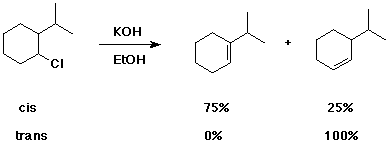![]()
![]()
1. Consider the chlorination of methane. The initiation step involves the dissociation of Cl2 using either light or heat. Alternatively, tetramethyl lead ((CH3)4Pb) can be added to initiate this same reaction at a lower temperature. The Pb-C bond energy in (CH3)4Pb is 49 kcal/mol.
a. Show the initiation and propagation steps for the chlorination of CH4 using (CH3)4Pb with CH4 and Cl2. Explain why lower temperatures are needed for the reaction with (CH3)4Pb than with Cl2 as the initiator.
b. An alternative to the accepted mechanism for the chlorination of methane is given below.
This mechanism does not operate to any significant extent under normal conditions. Calculate the enthalpies of each step and suggest a reason why this mechanism cannot compete with the accepted one.
c. When a small amount of iodine is added to a mixture of chlorine and methane, it prevents chlorination from occurring. Therefore, iodine is a free-radical inhibitor for this reaction. Calculate delta H values for the possible reactions of iodine with species present in the chlorination of methane, and use these values to explain why iodine inhibits the reactions.
2. a. The reaction of 3-methyl-2-butanol with HBr gives 2-bromo-2-methylbutane. Write a complete mechanism that explains why this is the major reaction product. The "expected" product, 2-bromo-3-methylbutane, can be formed by adjusting the reaction conditions to include a large excess of NaBr. Show how you would modify the mechanism to include a pathway to this product.
b. The reaction of 3-methyl-2-butanol with hot H3PO4 gives three elimination products, in yields of 64%, 33% and 3%. Write a complete mechanism, which should start out analogously to part (a) above, and predict the structures of the three products. Why are substitution products formed in part (a) but are not formed in this case?
3. Elimination from 1-chloro-2-isopropylcyclohexane can give different products, as shown below. Write good chair forms for the two conformations of the cis isomer and write a detailed electron-pushing mechanism to predict the preferred product in this case.
Do the same with the trans isomer. Explain the distinctive differences in the two cases.
One of the isomers reacts much faster than the other. Predict which is faster and explain the difference.

Materials adapted from:
Peer-Led Team Learning: Organic Chemistry, 1/e
Jack A. Kampmeier, University of Rochester
Pratibha Varma-Nelson, St. Xavier University
Donald Wedegaertner, University of the Pacific
Prentice-Hall, 2001, ISBN 0-13-028413-0
http://www.sci.ccny.cuny.edu/~chemwksp/OrganicChem.html